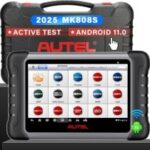A 1996 Dodge Ram 2500 with an automatic transmission and 370,000 miles is experiencing a no-communication issue at the OBD2 port after a transmission swap. Initially, the truck had shifting problems, only shifting into 1st, 2nd, and 3rd gears without overdrive or lockup. After swapping solenoids, sensors, and the wiring harness from the original transmission to the replacement, overdrive and lockup functionality returned, but the truck will not automatically downshift from 3rd gear. A transmission shop attempted to diagnose the issue using a scanner, but they couldn’t establish communication with the OBD2 port.
Power and ground at the OBD2 port have been verified. Resistance checks on the violet and black/white wires between the instrument cluster and the powertrain control module (PCM) show good readings. The possibility of a faulty PCM is suspected.
Several potential causes for a no-communication issue at the OBD2 port on a 1996 Dodge Ram include:
- Faulty PCM: A malfunctioning PCM can prevent communication with the diagnostic scanner.
- Wiring Issues: Damaged or corroded wiring in the data link connector (DLC) circuit or between the DLC and the PCM can disrupt communication. Check for breaks, shorts, or loose connections in the wiring harness.
- Blown Fuse: A blown fuse in the DLC circuit can cut off power to the port, preventing communication. Consult the owner’s manual to identify the correct fuse.
- Bad Ground: A poor ground connection at the PCM or DLC can interfere with communication. Ensure all ground connections are clean and tight.
- DLC Connector Problems: The DLC connector itself may be damaged or have bent pins, hindering connection with the scanner. Inspect the connector for any signs of damage.
Further diagnostic steps include:
- Check for Communication with Other Modules: Using a compatible scan tool, attempt to communicate with other modules on the vehicle network, such as the ABS or airbag module. Successful communication with other modules suggests a problem isolated to the DLC circuit or PCM.
- Bypass the DLC: Directly connect the scan tool to the PCM using appropriate wiring diagrams and connectors. Successful communication this way points to a problem with the DLC or its wiring.
- Chrysler-Specific Scan Tool: Some aftermarket scan tools may not be fully compatible with older Chrysler vehicles. Using a Chrysler-specific scan tool, like a DRB-III, might establish communication.
While the transmission shifting problem and the OBD2 communication issue may be unrelated, it’s possible a faulty PCM is contributing to both. A thorough diagnosis of the communication problem should be completed before addressing the transmission issue further. This will help avoid unnecessary part replacement.
